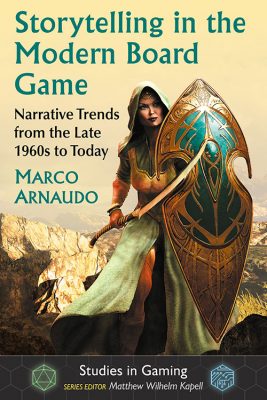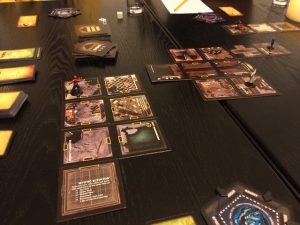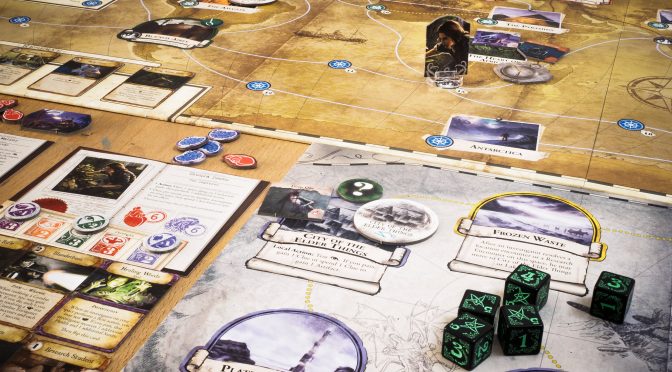Marco Arnaudo. Storytelling in the Modern Board Game: Narrative Trends from the Late 1960s to Today. Jefferson, NC: McFarland, 2018. 226 pp. Softcover. $39.95 ISBN: 9781476669519
Storytelling in the Modern Board Game: Narrative Trends from the Late 1960s to Today is an excellent addition to the nascent contemporary study of analog board games, and will make a useful model for instructors or researchers interested in examining analog games through narratological lenses. In this book, Marco Arnaudo dives into a specific topic of interest to many contemporary gamers: board games that tell stories. By bringing a narratological methodology to analog board games, Arnaudo develops both an understanding of how games can tell stories as well as why storytelling matters in gaming.

In the opening Preface of the book, Arnaudo notes that he draws from two academic fields: Game Studies and Narratology. Balancing between the two is a tightrope walk: he of course mentions the narratology/ludology debate in Game Studies, but is also quick to note that “since theory must always adjust itself to fit reality, and not vice versa, our scholarship must yield to the community of players if such a community decides to embrace or reject the idea of stories in games.”1 Thus, he largely eschews larger theoretical discussions in favor of focusing on on-the-ground play, seen through an atheoretical lens. It also signals his desire to place the player as the central figure in board game discussions.
His narratological focus is easy to see: the introduction and first two chapters of the book, as well as the Epilogue, focus on the unique narrative elements that constitute storytelling within board games. Arnaudo believes, quite rightly, that board games cannot produce the same type of stories that we might traditionally see emerging from literature and film, media that can only “tell us what kind of story a game can tell”; instead, he claims, “only game studies can tell us how that result is achieved, and how the ludic and material elements of a design contribute to the construction and perception of the message.”2 This missing piece of the equation, imported from game studies here, is the role of the player in the storytelling process: players have a “crucial role of soliciting the narrative by manipulating the components, rearranging the blocks of the story, interpreting the content, and mentally filling in the gaps between the various thematic units.”3 No board game meaning can be expressed without player involvement; unlike a film, book, comic, or even a video game (whose algorithmic procedures pre-program in narrative moments), board games are static until players invest in them.4
Chapter 1, specifically, applies characteristics from narratology to games-that-tell-stories. In order to do this, Arnaudo presents 13 parameters that, he argues, help define narrative within games. He creates an inductive argument about each of these parameters in detail by applying them to numerous examples of specific board games.5 Some of these parameters are broad, including, “the content [of the game] is depicted in the components consistently”; others are more specific and arguable, “The players control individual characters (the traditional focus of storytelling) rather than groups or abstract entities.”6 One might quibble by pointing out examples where this may not be the case, but it is in this chapter that Arnaudo’s facility with contemporary game scholarship is evidenced: he brings games scholars like Mark J.P. Wolf into conversation with narrative scholar Mieke Bal,7 for example, articulating ways that board games create the same type of alternate worlds that populate our cult media.8
Chapter 2 outlines the characteristics of the types of stories that board games do tell, including discussions of genre, point-of-view, representations of time, and player identification. It’s this last point that is the most interesting, as it offers a uniquely ludic perspective on narrative. How does one turn an inherently interactive activity into a story-driven experience? Arnaudo here links the (ludic) following of game rules to the players’ narrative telling:
“The best story-driven board games come to life through smooth and organic systems of rules that do not require deviations from the system to express a pleasurable narrative. When this occurs, the mechanics of the game start feeling like second nature and easily fade into a distant background in the players’ mind, making it possible to establish a deep connection with the theme and the characters in the game.”9
For Arnaudo’s analysis of board game storytelling, separating narrative and player is impossible. Nevertheless, I found myself hoping for more examinations of the players themselves in the book as a whole. Indeed, with the exception of a few quotes from users on BoardGameGeek (e.g., p. 180), the book offers little exploration of players’ reaction to storytelling in board games. This wasn’t part of Arnaudo’s remit, so I don’t fault him for the absence, but given the explicit linkage between narrative, player, and the ludic in games-that-tell-stories, more could have been made of players’ own experiences with storytelling, and how interactive storytelling (and story receiving) can herald new directions in narrative.
The other chapters in the book (3-12), shorter and less analytic, have a more historical bent. Scholars of games may be interested in the way Arnaudo outlines the development of storytelling in games, from 19 and early 20th century wargaming, to the rise of storytelling games like Dungeons & Dragons (1974/2015), through today’s popular Legacy-style games. Arnaudo’s deep knowledge of board games is evident in almost casual way he mentions hundreds of different games as examples in the volume. Indeed, for readers who are new to the hobby, I would be hard-pressed to recommend a more comprehensive selection of games-that-tell-stories than what Arnaudo mentions; and for readers who are already very familiar with board gaming, I would bet that at least one or two new titles will appear. Readers of all stripes will enjoy the jolt of frisson upon encountering the name of a long-lost (or long-forgotten) favorite game.
Chapter 3 discusses the relationship between theme and mechanics in board games, specifically examining the rise of Dungeons & Dragons as both a role-playing game and as an influence on a range of analog game titles emerging in the 1970s. Chapter 4 takes a similar tack and explores the influence of J.R.R. Tolkien’s The Hobbit (1937) and The Lord of the Rings (1954) on both war- and board gaming. Game scholars may be particularly interested in Arnaudo’s dichotomous classification of analog fantasy games from the 1970s as either “Tolkienesque games,” which “employ the techniques of strategic and operational wargaming to capture the epic flair of The Hobbit and The Lord of the Rings”10 and the “‘Howardian,’ “Leiberian,’” or ‘Dungeonesque” games, which “bring individual characters to the foreground, and mainly deal with stories of exploration and self-aggrandizement.”11 In traditional narrative terms, we may consider these typical generic terms: games of collective storytelling or competitive conflict.
Chapters 5–7 draw further into the history of games-that-tell-stories, looking at the late 1970s and early 1980s, after the success of Dungeons and Dragons. Arnaudo discusses space and place in gaming as an aspect of narrative development and continues the historical look at narrative in games, bringing in the rise of big box games in the 1980s including Talisman (1983) by Robert Harris. All three of these chapters mainly situate narrative historically in games, and Arnaudo’s encyclopedic knowledge of games comes to the fore in his abundant examples of the genres.
Chapter 8 introduces paragraph-based storytelling games as a link between RPGs and board games; these games feature storytelling through long booklets of numbered paragraphs that describe thousands of situations that might occur in the storyworld. The litany of examples serves in Arnaudo’s favor most of the time, as he focuses not on deep analysis of any one particular game, but rather on the larger narrative styles that have emerged across board games over time. At the same time, some of the most interesting analyses in the book are when he goes in depth about particular games, as with his (in comparison) longer analysis of Sherlock Holmes: Consulting Detective (1981)12 in this chapter, and Betrayal at House on the Hill (2004)13 in Chapter 11.

In Chapter 9, Arnaudo begins a move from games of the pre-digital age to contemporary concerns related to board gaming by focusing on an era of what he refers to as overproduction, or the “unnecessarily large and excessively elaborate pool of components” found in many games of the 1980s and early 1990s.14 It is this analysis that I think would have benefited the most from more ethnographic detail; it is hard not to see some of this as simply Arnaudo’s personal preference for sleeker, less material games:
“Different players of course may disagree on where exactly high production ends and overproduction begins, but anyone who looks at the hobby board games of the late 1980s and early 1990s will likely concur that the market was moving decidedly in the direction of bigger, heavier, and more materially intricate productions, regardless of which side of the dilemma this or that game may fall individually.”15
Indeed, the appeal of many games for players may just be that excessive materiality—the joy of the tangible or the collectible can become just as important as the gameplay to players.16 Arnaudo even notes this in his discussion of Dark Tower (1981), a game known for its impressively large electronic tower in the center of the board.17 Overproduction may in fact be in the eye of the beholder, as we can see today in the popularity of games like Gloomhaven (2017) and Hellboy (2019), or the continued relevance of mechanics like HeroClix (2002).
Chapter 10 returns again to Dungeons & Dragons and the ties between board gaming and roleplaying in the early 2000s, when the 3rd and 3.5th editions were released. Arnaudo links this in Chapter 11 to the conflict between board games and digital games at the turn of the millennium, when video games were seen to be destroying the board game hobby. He notes that three types of games survived in this era: the role-playing game, the collectible card game (CCG) like Magic: The Gathering (1993), and the Eurogame (popularized in the States by Settlers of Catan (1995)). By combining storytelling elements from RPGs, high player engagement via CCGs, and the attention to mechanics in euro games, the post-2000 board game “comeback” utilized a synergy between theme and mechanics as “the narratives that emerged became more compelling and immersive than ever.”18 Today, for Arnaudo, board games and the digital environment work hand-in-hand; board gamers turn to the Internet for rules reference and online tutorials, print-and-play games, community, and many more. Arnaudo himself is part of this digital revolution: in addition to being a professor of French and Italian at Indiana University, Marco Arnaudo is also a prolific creator of online board game video reviews, which helps explain the wealth of examples in the book.19
In Chapter 12, Arnaudo turns to arguably the most avant-garde aspect of narratives in contemporary board games—the Legacy game. Deliberately designed as campaigns where the later scenarios are hugely influenced by the actions of the players in earlier scenarios, Legacy games pivot on what Arnaudo takes to be “one of the holiest pillars of conventional gaming,” replayability.20 Because the state of the board changes in Legacy games (for example, a session of Pandemic Legacy – Season 1 (2015) may find whole cities being overrun with the plague, which in later scenarios would mean that those cities are no longer habitable), once the requisite number of scenarios are completed, the game is complete. Arnaudo links this sense of “progressive revelation” in contemporary narrative games to traditional narratological ideas like the “plot twist.”21 Indeed, if nothing else, the popularity of Legacy games in the board game community22 highlights the need for a book like Storytelling in the Modern Board Game: exploring not why highly narrativized games have emerged, but how they have always been a part of the board gaming experience.
Storytelling in the Modern Board Game is perfect for the classroom, as students may wish to learn more about the history and application of narrative in board games. It will also appeal to the scholar interested in the ruptures between narrative and the ludic, and the role of player investment in games-that-tell-stories. Overall, it is an eminently readable exploration of an underexamined facet of contemporary board gaming.
–
Featured Image 197/365: Eldritch Horror by Guido Gloor Modjib CC-BY @Flickr
–
Paul Booth is Associate Professor of Communication at DePaul University, USA. He is the author of Game Play: Paratextuality in Contemporary Board Games (Bloomsbury, 2015).

